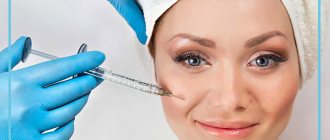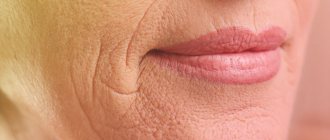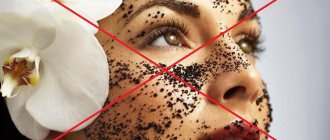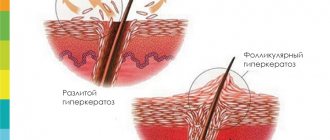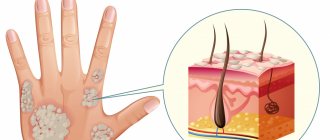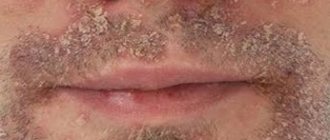Dental diseases include not only various problems with teeth, but also with lips, gums and simply the oral cavity. For example, cheilitis is an inflammation of the mucous membrane of the lips, which is characterized by the appearance of cracks in them. There is simple cheilitis (on the lips) and angular or angular cheilitis (in the corners of the lips), but there are also other types that depend on the causes. These types will be described a little later in the article.
The main symptoms of this disease
To suspect you have cheilitis and consult a dentist, you need to know the symptoms of this disease:
- Lips swell and become inflamed.
- The lips or the border around them become much redder than before.
- Cracks appear in the corners of the lips.
- Sometimes lips peel or crack.
- Sometimes lips become very dry.
- Sometimes your lips hurt or itch.
- Sometimes inflammation occurs in the form of gray or yellow blisters and ulcers (especially in advanced conditions).
As soon as all or some symptoms are detected (as you can see, many do not necessarily appear), you must immediately consult a doctor so that he can conduct the necessary examination, take tests and prescribe treatment.
Causes of cheilitis
Cheilitis can be an independent disease and a manifestation of other pathologies of the mucous membranes and internal organs. The most common causes of the disease include:
- Dermatoses. The mucous membranes and skin of the lips can be involved in the pathological process in lichen planus, psoriasis, erythematoses and other skin diseases.
- Unfavorable factors. Exposure to hot and cold air, wind, and excessive exposure to UV rays are especially common causes of cheilitis in people who work outdoors and under special weather conditions.
- Allergic reactions. Allergies can be triggered by chemical factors, ultraviolet rays, cosmetics, etc.;
- Other diseases. Secondary cheilitis often develops against the background of atopic dermatitis, eczema, neuritis of the facial nerve, etc.
Natural protective mechanisms are weakened by such factors as hypothermia, previous surgical interventions, long-term antibacterial therapy, hypovitaminosis, etc.
Ask a Question
Why does lip inflammation develop?
There are many reasons for the occurrence of cheilitis. Different reasons cause different types of lip inflammation. However, there are some common catalysts, for example, deficiency of vitamins, iron, calcium, excessive use of various medications (for example, antibiotics), constant exposure to drafts or living in a city with very low air temperatures in winter, strong and regular ultraviolet radiation, poor immunity.
The causative agents of allergic cheilitis are, of course, allergic reactions to cosmetics or food, infectious - various diseases (viruses, fungi), glandular - dermatological diseases, meteorological - frequent chapped lips and being outside without hygienic lipstick, and candidal - stomatitis and simply poor care behind the oral cavity.
Exfoliative cheilitis occurs in those who often bite off pieces of skin from their lips or simply constantly lick them (observed only in women). These actions can be triggered by frequent anxiety and stress. Manganotti cheilitis occurs only in adult men and is provoked by various injuries to the oral cavity, stomach diseases, frequent and long exposure to the sun or in a solarium, as well as clear signs of aging, which are caused by the fact that the mucous membrane is now regenerating more slowly. Hypovitaminosis occurs due to a lack of vitamins B2, B2 and other B vitamins.
The most common lip problems are dryness, flaking and cracking. The reason for this is the structural features of the lips. As is known, they are divided into three parts: cutaneous, intermediate and mucous.
- the skin part has a structure similar to that of ordinary skin. It is covered with the epidermis, which is a stratified squamous keratinizing epithelium, and contains appendages - sebaceous, sweat glands and hair follicles with hair;
- the intermediate part - the red border of the lips, in everyday perception is called the lips, is also covered with a stratum corneum, which, however, is very quickly renewed and relatively “immature” cells rise to the surface. In addition, the red border of the lips does not contain skin appendages, but contains a large number of blood vessels and nerve endings;
- The mucous part occupies the posterior surface of the lips and is covered with stratified squamous non-keratinizing epithelium. Moistened with the secretion of the labial salivary glands.
It is precisely because of the rapid renewal of the stratum corneum, as well as the absence of sebaceous and sweat glands, that the skin of the red border of the lips has poor protective barriers, and therefore easily loses water and is sensitive to changes in environmental conditions.
The secretion of the sebaceous and sweat glands of the skin forms a hydrolipid mantle, which is the first line of defense of the skin, causing a pH gradient, which is necessary, among other things, for the normal functioning of enzymes in the stratum corneum and maintaining the functioning of a healthy microbiome, as well as a surface lipid barrier.
As for the rapid renewal of the stratum corneum of the red skin of the lips, such intensity of division does not allow the structures of the epidermis to “mature” normally. As a result, the horny scales and lipid layers of the stratum corneum do not form a sufficiently dense barrier; it remains more permeable than the barrier of normal skin. As a result, this causes accelerated water loss and dry skin. In addition, the latter provokes another problem - it is believed that trypsin- and chymotrypsin-like enzymes play a role in the degradation of desmosomes, the elements that ensure the adhesion of epidermal cells, and the water content in the stratum corneum is mentioned as a factor regulating the activity of these enzymes. Accordingly, with its deficiency, the enzymes do not work effectively enough and complete destruction of desmosomes does not occur - as a result, we observe peeling of the lips. It intensifies under the influence of various external factors - cold, wind, ultraviolet radiation, sharp temperature contrasts, dry air of rooms heated in winter, etc., since if the barrier functions of the skin are insufficient under these conditions, an even greater loss of water occurs and desquamation processes are further disrupted. In addition, against the background of dryness, cracks appear, which cause significant discomfort - as mentioned above, the skin of the lips is very actively innervated. In connection with the above, the main lip care products are considered to be balms containing occlusive components, i.e. those that prevent the evaporation of water from the skin.
Science-Based Lip Care
As you know, there are two fundamentally different ways to moisturize the stratum corneum. The first is to use a non-aqueous ointment based on petroleum jelly or silicone, which creates an occlusive layer on the skin to inhibit the evaporation of water: water accumulates in the stratum corneum and its level of hydration increases.
The second way is to bring water from outside with the help of preparations containing it. These can be gels (water + colloid) or emulsions (water + oil), which contain components that bind water (wetting agents). Moisturizing agents with low molecular weight (such as natural moisturizing factor components and ions) penetrate into the stratum corneum itself, accumulate there and attract water. High-molecular compounds (proteins, polysaccharides, glycols) remain on the surface of the skin and form a kind of wet compress.
The main ingredient in lip care products is most often Vaseline, which is considered one of the most powerful occlusive agents. However, it only retains moisture without restoring the natural barrier properties of the lips, on the contrary - due to the fact that Vaseline moisturizes too well, it can slow down the restoration of the epidermal barrier, the cells will not receive a signal in time that the barrier needs repair.
It is generally accepted that if barrier function cannot be restored (for example, in atopic dermatitis due to genetic defects), occlusive agents are necessary for permanent use. However, when you stop using them, everything usually returns to normal, some people even develop a kind of “dependence” on lip balms - if they apply them, relief comes, but as soon as they stop using these products, complaints about dryness and flaking return again. Therefore, if there is still a chance to restore barrier structures, occlusive agents should be used only at the initial stage.
And in the case of the barrier function of the lips, there is such a chance. And this is another way to increase skin hydration and restore its natural protective barrier. Recent studies have shown that in the lipid layers of the stratum corneum of the skin, the balance of ceramides is disturbed - one of the main (and most significant in quantity) components of the lipid barrier, along with cholesterol and free fatty acids (all these lipids are classified as so-called physiological lipids). Intercellular lipids of the stratum corneum hold the scales together (“cement”) and form the basis of the permeability barrier (lipid barrier), which prevents the diffusion of substances through the stratum corneum in both directions. A change in the ratio of lipids in the composition of the lipid barrier leads to disruption of its function.
It has been shown that in the stratum corneum of the red border of the lips, the amount of ceramides as such is generally reduced, while their imbalance is also observed - a higher percentage of such ceramide subtypes as CER [NS] (with short-chain CER [NS] dominating) and CER [AS ] and a lower percentage of CER [NP] and CER [NH] compared to other areas of the body skin.
In a recent study, Japanese scientists examined whether ceramides could reduce lip dryness and flaking as well as highly occlusive formulations. They used synthetic pseudoceramide (pCer, Cetyl PG hydroxyethyl palmitamide), which has already proven itself in the treatment of atopic dermatitis. Moreover, this pseudoceramide was included in the composition of the product that does not provide occlusion.
The study involved 31 healthy women (age range from 21 to 37 years; average age 28.6 years) with normal skin and complaints of dry lips. All women were divided into three groups according to the products used: control (a product without ceramides, which has moderate occlusive properties and confirmed its effect in one of the scientists' previous trials), a non-occlusive product with 0.5% pCer and with 2.0% pCer. Each sample was applied four times a day (morning, noon, evening, before bed) for 4 weeks. The degree of lip roughness, lip hydration, rate of transepidermal water loss (TEWL) and elasticity of the lip surface were assessed. Endogenous ceramide profiles and pCer absorption levels in the stratum corneum were also determined.
As a result, after 4 weeks in the group of women who used the drug 2.0% pCer, there was a significant decrease in roughness compared to the initial level, as well as with the drug with lower concentrations of ceramide and the control occlusive agent. Moreover, the improvement increased by the 4th week, at a time when by this time the effect of 0.5% of the drug had only appeared. Also, by week 4, the 2.0% pCer group showed a decrease in TEWL and an increase in lip hydration and elasticity. Interestingly, hydration and TEWL rates also improved in the control occlusive group by the second week, but then gradually decreased. A decrease in the amount of CER [NS] was also noted, an increased concentration of which is found not only on the lips, but also in atopic dermatitis, i.e. it is a marker of skin barrier failure. The amount of CER [NH], the low content of which has a high correlation with lip roughness, and CER [NP] also increased.
Regarding the absorption of pCer, it is quite natural that the higher its content, the better the absorption. However, since the amount of pCer absorbed at 2 weeks was much greater than at 4 weeks, this was also associated with increased lip roughness at first. By improving this parameter, absorption may stabilize.
What conclusions can be drawn from this information? For lip care, it is effective to use not just occlusive preparations that retain water, but to strengthen the natural barrier function of the lip skin with the help of physiological lipids - primarily in the form of ceramides. And the better the restoration of the lipid barrier, the less “dependence” you will have on classic Vaseline-based lip balms.
Sources:
Arai S., Oshida, K., Hikima, T. and Fukuda, Y. Study on lip surface-characteristics of stratum corneum and corneocytes on lip. J. Jap. Cosmet. Sci. Soc. 14, 66–70 (1990).
Arai, S., Oshida, K., Hikima, T. and Hasunuma, K. Study on lip surface-characteristics of chapped lip. J. Jap. Cosmet. Sci. Soc. 13, 64–68 (1989).
Hikima, R., Igarashi, S., Ikeda, N. et al. Development of lip treatment on the basis of desquamation mechanism. IFSCC Mag. 7, 3–10 (2004).
Ishikawa J., Shimotoyodome, Y., Ito, S., Miyauchi, Y., Fujimura, T., Kitahara, T., Hase, T. Variations in the ceramide profile in different seasons and regions of the body contribute to the stratum corneum functions. Arch. Dermatol. Res. 305, 151-162 (2013).
Shimotoyodome Y., Tsujimura, H., Ishikawa, J., Fujimura, T., Kitahara, T. Variations of ceramide profile in different regions of the body of Japanese females. J. Jap. Cosmet. Sci. Soc. 38(1), 3-8 (2014).
Imokawa G. A possible mechanism underlying the ceramide deficiency in atopic dermatitis: expression of a deacylase enzyme that cleaves the N-acyl linkage of sphingomyelin and glucosylceramide. J. Dermatol. Sci. 55, 1–9 (2009).
Tamura E., Yasumori H., Yamamoto T. The efficacy of a highly occlusive formulation for dry lips. Int J Cosmet Sci. 2020 Feb;42(1):46-52.
Tamura E., Ishikawa J., Yasuda Y., Yamamoto T. The efficacy of synthetic pseudo-ceramide for dry and rough lips. Int J Cosmet Sci. 2020 Nov 30.
Treatment methods
The treatment plan for cheilitis is developed individually, depending on the form of the disease, the severity of symptoms, and the characteristics of the health condition. Thus, in the treatment of the exfoliative form of the disease, the key element of effective treatment is the impact on the psycho-emotional sphere: you will need to contact a neurologist or psychoneurologist to prescribe sedatives and antidepressants according to indications. Consultation with an endocrinologist may be required.
Local treatment may involve the use of laser or ultrasound physiotherapy, local anti-inflammatory drugs, and less commonly, radiation therapy. Elimination of excessive dryness is possible with the help of hygienic lipsticks. To speed up recovery, the doctor may prescribe vitamin therapy, UVOC and other methods of maintaining the body's defenses.
Therapy for glandular cheilitis consists of using local anti-inflammatory agents. Antibacterial, antiviral, and hormonal ointments can be used. A radical method of therapy is electrocoagulation of the salivary glands or their surgical removal, as well as laser ablation. These methods are used when conservative methods are ineffective. After the main course, the doctor will prescribe medications to prevent relapses - they will eliminate dry or weeping skin. It is important to sanitize the oral cavity in a timely manner and undergo professional teeth cleaning.
Treatment of atopic cheilitis consists of eliminating irritating factors. Drugs with antipruritic and anti-inflammatory effects can be used locally, and therapy with antihistamines with a systemic effect is also carried out. The use of glucocorticosteroids allows you to get quick relief, but it is important to strictly adhere to medical prescriptions - they can only be used for a short time. It is important to follow a hypoallergenic diet and remove allergenic foods from the diet.
Therapy for meteorological cheilitis begins with limiting harmful effects, for example, insolation. Local treatment is usually carried out - the doctor prescribes hormonal agents and protective creams, including those with SPF. The course of treatment is supplemented with vitamins - vitamin-mineral complexes or individual preparations (B, PP, C, etc.).
In the treatment of macrocheilitis, immunocorrective and antiviral therapy is of particular importance. The doctor may prescribe:
- hormonal anti-inflammatory drugs of systemic action;
- novocaine blockades;
- antihistamines, etc.
Laser therapy can have a positive effect on the correction of the entire triad of symptoms. Other physical therapy methods have been successful in treating facial neuritis.
Possible complications
Failure to see a doctor in a timely manner often causes serious complications. The disease itself often does not pose a serious health risk. But only an experienced specialist can tell you how to treat cheilitis. Self-medication can lead to unpleasant consequences and provoke the occurrence of a chronic form of the disease. In addition, cheilitis is dangerous because its symptoms can mask malignant tumor processes. It is important to remember that some forms are prone to malignancy - cheilitis may be followed by precancerous conditions.
Symptoms of seizures in the corners of the mouth
Clinical manifestations and symptoms of the lesion depend on many factors and stages. It usually begins with redness of the skin in the corners of the mouth, peeling, and the appearance of bursting blisters. Areas of erosion appear on the mucous membrane and skin of the corner, which become covered with a crust, when ruptured, cracks of varying depths can form.
In areas of inflammation, constant itching is felt, pain appears when opening the mouth, pain when eating spicy food. It is especially typical that a sharp pain appears in the morning, after sleep, when you first open your mouth.
But in some rare cases, obvious pain symptoms are mild, especially in elderly people, or in people suffering from diabetes mellitus (when seizures appear as a consequence of candidal stomatitis).





